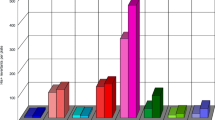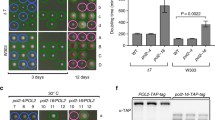Abstract
The mutation affecting DNA polymerase activity in the mutant strain isolated by De Lucia and Cairns is located between metE and rha, at approximately 75 minutes on the Escherichia coli chromosome. The mutation is recessive to the wild-type gene in partial diploids. It is an amber nonsense mutation which responds to the suppressors Sul+, Sull+ and Sulll+. Strains carrying the mutation are not deficient in carrying out genetic recombination.
Similar content being viewed by others
References
De Lucia, P., and Cairns, J., Nature, 224, 1164 (1969).
Willson, C., Perrin, D., Cohn, M., Jacob, F., and Monod, J., J. Mol. Biol., 8, 582 (1964).
Scaife, J., and Gross, J. D., Genet. Res. Camb., 4, 328 (1963).
Taylor, A. L., and Trotter, C. D., Bact. Rev., 31, 332 (1967).
Brenner, S., and Beckwith, J. R., J. Mol. Biol., 13, 629 (1965).
Calender, R., and Lindahl, G., virology (in the press).
Ogawa, H., Shimada, K., and Tomizawa, J., Mol. Gen. Genetics, 101, 227 (1968).
Author information
Authors and Affiliations
Rights and permissions
About this article
Cite this article
GROSS, J., GROSS, M. Genetic Analysis of an E. coli Strain with a Mutation affecting DNA Polymerase. Nature 224, 1166–1168 (1969). https://doi.org/10.1038/2241166a0
Received:
Issue Date:
DOI: https://doi.org/10.1038/2241166a0
- Springer Nature Limited
This article is cited by
-
Escherichia coli DNA polymerase II is homologous to α-like DNA polymerases
Molecular and General Genetics MGG (1991)
-
DNA sequence analysis of spontaneous mutation in a PolA1 strain of Escherichia coli indicates sequence-specific effects
Molecular and General Genetics MGG (1987)
-
Plasmid cloning and expression of the E. coli polA + gene in S. cerevisiae
Current Genetics (1984)
-
DNA polymerases in prokaryotes and eukaryotes: Mode of action and biological implications
Experientia (1983)
-
Alignment of cloned amiE gene of Pseudomonas aeruginosa with the N-terminal sequence of amidase
Bioscience Reports (1981)





